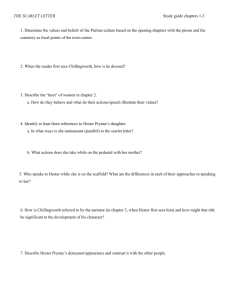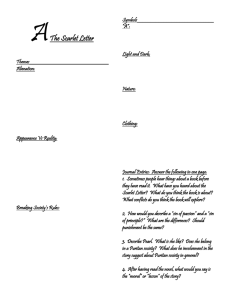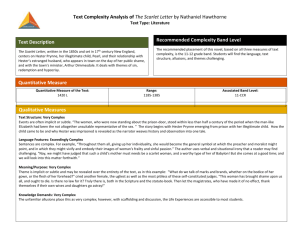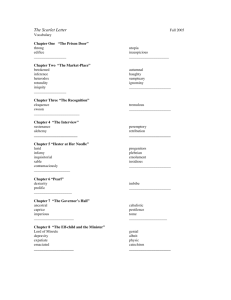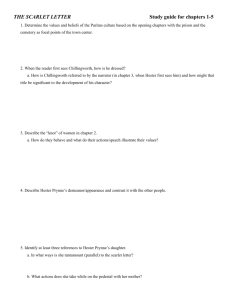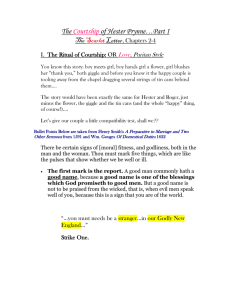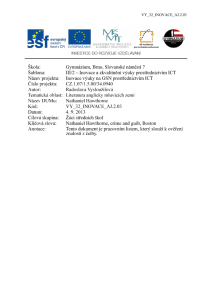The Scarlet Letter and Hester Prynne
advertisement
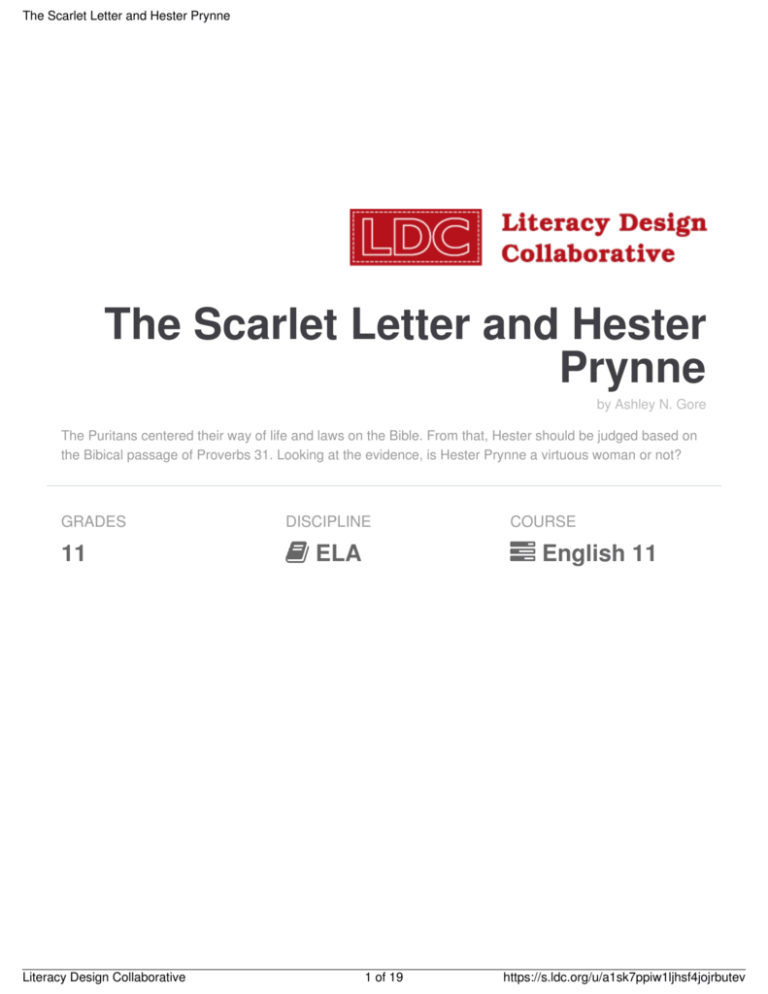
The Scarlet Letter and Hester Prynne The Scarlet Letter and Hester Prynne by Ashley N. Gore The Puritans centered their way of life and laws on the Bible. From that, Hester should be judged based on the Bibical passage of Proverbs 31. Looking at the evidence, is Hester Prynne a virtuous woman or not? GRADES DISCIPLINE COURSE 11 ELA English 11 Literacy Design Collaborative 1 of 19 https://s.ldc.org/u/a1sk7ppiw1ljhsf4jojrbutev The Scarlet Letter and Hester Prynne Section 1: What Task? Teaching Task Task Template 6 - Argumentation Is Hester Prynne a virtuous woman? After reading The Scarlet Letter, write an essay in which you discuss Hester's Prynne's character attributes and evaluate her virtues in connection with Proverbs 31 . Support your position with evidence from the text(s). Standards CCSS Common Core State Standards for English Language Arts & Literacy in History/Social Studies, Science, and Technical Subjects RL.11-12.1 Cite strong and thorough textual evidence to support analysis of what the text says explicitly as well as inferences drawn from the text, including determining where the text leaves matters uncertain. RL.11-12.2 Determine two or more themes or central ideas of a text and analyze their development over the course of the text, including how they interact and build on one another to produce a complex account; provide an objective summary of the text. RL.11-12.4 Determine the meaning of words and phrases as they are used in the text, including figurative and connotative meanings; analyze the impact of specific word choices on meaning and tone, including words with multiple meanings or language that is particularly fresh, engaging, or beautiful. (Include Shakespeare as well as other authors.) RL.11-12.7 Analyze multiple interpretations of a story, drama, or poem (e.g., recorded or live production of a play or recorded novel or poetry), evaluating how each version interprets the source text. (Include at least one play by Shakespeare and one play by an American dramatist.) RL.11-12.10 By the end of grade 11, read and comprehend literature, including stories, dramas, and poems, in the grades 11—CCR text complexity band proficiently, with scaffolding as needed at the high end of the range. By the end of grade 12, read and comprehend literature, including stories, dramas, and poems, at the high end of the grades 11—CCR text complexity band independently and proficiently. Literacy Design Collaborative 2 of 19 https://s.ldc.org/u/a1sk7ppiw1ljhsf4jojrbutev The Scarlet Letter and Hester Prynne W.11-12.1 Write arguments to support claims in an analysis of substantive topics or texts, using valid reasoning and relevant and sufficient evidence. W.11-12.1.a Introduce precise, knowledgeable claim(s), establish the significance of the claim(s), distinguish the claim(s) from alternate or opposing claims, and create an organization that logically sequences claim(s), counterclaims, reasons, and evidence. W.11-12.1.b Develop claim(s) and counterclaims fairly and thoroughly, supplying the most relevant evidence for each while pointing out the strengths and limitations of both in a manner that anticipates the audience's knowledge level, concerns, values, and possible biases. W.11-12.1.c Use words, phrases, and clauses as well as varied syntax to link the major sections of the text, create cohesion, and clarify the relationships between claim(s) and reasons, between reasons and evidence, and between claim(s) and counterclaims. W.11-12.1.d Establish and maintain a formal style and objective tone while attending to the norms and conventions of the discipline in which they are writing. W.11-12.1.e Provide a concluding statement or section that follows from and supports the argument presented. W.11-12.4 Produce clear and coherent writing in which the development, organization, and style are appropriate to task, purpose, and audience. W.11-12.5 Develop and strengthen writing as needed by planning, revising, editing, rewriting, or trying a new approach, focusing on addressing what is most significant for a specific purpose and audience. W.11-12.9 Draw evidence from literary or informational texts to support analysis, reflection, and research. W.11-12.9.a Apply grades 11—12 Reading standards to literature (e.g., "Demonstrate knowledge of eighteenth-, nineteenth- and early-twentieth-century foundational works of American literature, including how two or more texts from the same period treat similar themes or topics"). Literacy Design Collaborative 3 of 19 https://s.ldc.org/u/a1sk7ppiw1ljhsf4jojrbutev The Scarlet Letter and Hester Prynne W.11-12.9.b Apply grades 11—12 Reading standards to literary nonfiction (e.g., "Delineate and evaluate the reasoning in seminal U.S. texts, including the application of constitutional principles and use of legal reasoning [e.g., in U.S. Supreme Court Case majority opinions and dissents] and the premises, purposes, and arguments in works of public advocacy [e.g., The Federalist, presidential addresses]"). W.11-12.10 Write routinely over extended time frames (time for research, reflection, and revision) and shorter time frames (a single sitting or a day or two) for a range of discipline-specific tasks, purposes, and audiences. Kentucky Kentucky Core Academic Standards - English Language Arts RL.11-12.1 Cite strong and thorough textual evidence to support analysis of what the text says explicitly as well as inferences drawn from the text, including determining where the text leaves matters uncertain. RL.11-12.7 Analyze multiple interpretations of a story, drama, or poem (e.g., recorded or live production of a play or recorded novel or poetry), evaluating how each version interprets the source text. (Include at least one play by Shakespeare and one play by an American dramatist.) W.11-12.4 Produce clear and coherent writing in which the development, organization, and style are appropriate to task, purpose, and audience. W.11-12.1.a Introduce precise, knowledgeable claim(s), establish the significance of the claim(s), distinguish the claim(s) from alternate or opposing claims, and create an organization that logically sequences claim(s), counterclaims, reasons, and evidence. Custom Standards CUSTOM ACT Course English 11 Quality Core Standard A.1 Reading Across the Curriculum b. Read independently for a variety of purposes (e.g., for enjoyment, to gain information, to perform a task) c. Read increasingly challenging whole texts in a variety of literary (e.g., poetry, drama, fiction, nonfiction) and nonliterary (e.g., textbooks, news articles, memoranda) forms CUSTOM Literacy Design Collaborative 4 of 19 https://s.ldc.org/u/a1sk7ppiw1ljhsf4jojrbutev The Scarlet Letter and Hester Prynne ACT Course English 11 Quality Core A.2 Reading Strategies a. Apply strategies before, during, and after reading to increase fluency and comprehension (e.g., adjusting purpose, previewing, scanning, making predictions, comparing, inferring, summarizing, using graphic organizers) with increasingly challenging texts c. Demonstrate comprehension of increasingly challenging texts (both print and nonprint sources) by asking and answering literal, interpretive, and evaluative questions d. Use close-reading strategies (e.g., visualizing, annotating, questioning) in order to interpret increasingly challenging texts e. Compare texts to previously read texts, past and present events, and/or content learned in other coursework CUSTOM ACT Course English 11 Quality Core A.3 Knowledge of Literary and Nonliterary Forms a. Identify, analyze, and evaluate the defining characteristics of specific literary and nonliterary forms (e.g., satire, allegory, parody, editorial, essay, memorandum) and describe how form affects the meaning and function of the texts d. Identify and interpret works in various poetic forms (e.g., ballad, ode, sonnet) and explain how meaning is conveyed through features of poetry, including sound (e.g., rhythm, repetition, alliteration), structure (e.g., meter, rhyme scheme), graphic elements (e.g., punctuation, line length, word position), and poetic devices (e.g., metaphor, imagery, personification, tone, symbolism) CUSTOM ACT Course English 11 Quality Core A.5 Author’s Voice and Method c. Identify, analyze, and evaluate plot, character development, setting, theme, mood, and point of view as they are used together to create meaning in increasingly challenging texts e. Identify, analyze, and evaluate the ways in which the devices the author chooses (e.g., irony, imagery, tone, sound techniques, foreshadowing, symbolism) achieve specific effects and shape meaning in increasingly challenging texts h. Identify the author’s stated or implied purpose in increasingly challenging texts ACT Course English 11 Quality Core A.6 Persuasive Language and Logic c. Locate important details and facts that support ideas, arguments, or inferences in increasingly challenging texts and substantiate analyses with textual examples that may be in widely separated sections of the text or in other sources CUSTOM ACT Course English 11 Quality Core A.8 Words and Their History a. Apply knowledge of Greek, Latin, and Anglo-Saxon affixes, inflections, and roots to understand unfamiliar words and new subject matter vocabulary in increasingly challenging texts (e.g., words in science, mathematics, and social studies) b. Infer word meanings by analyzing relationships between words (e.g., synonyms, antonyms, metaphors, analogies) in increasingly challenging texts c. Use general and specialized dictionaries, thesauruses, and glossaries (print and electronic) to determine the definition, pronunciation, derivation, spelling, and usage of words d. Use context clues (e.g., author’s restatement, example) to understand unfamiliar words in increasingly challenging texts f. Identify and interpret common idioms and literary, classical, and biblical allusions (e.g., the garden of Eden as it is used in Thomas Hardy’s novel Tess of the D’Urbervilles) in increasingly challenging texts h. Apply knowledge of connotation and denotation to determine the meanings of words and phrases in increasingly challenging texts Literacy Design Collaborative 5 of 19 https://s.ldc.org/u/a1sk7ppiw1ljhsf4jojrbutev The Scarlet Letter and Hester Prynne CUSTOM ACT Course English 11 Quality Core B.1 Writing Process a. Use prewriting strategies (e.g., brainstorming, webbing, note taking, interviewing, background reading) to generate, focus, and organize ideas as well as to gather information CUSTOM ACT Course English 11 Quality Core B.2 Modes of Writing for Different Purposes and Audiences d. Craft first and final drafts of responses to literature that organize an insightful interpretation around several clear ideas, premises, or images and support judgments with specific references to the original text and to other texts or authors CUSTOM ACT Course English 11 Quality Core B.3 Organization, Unity, and Coherence a. Establish and develop a clear thesis statement for informational writing or a clear plan or outline for narrative writing b. Organize writing to create a coherent whole with effective, fully developed paragraphs, similar ideas grouped together for unity, and paragraphs arranged in a logical sequence c. Add important information and delete irrelevant information and details to more clearly establish a central idea d. Rearrange words, sentences, and/or paragraphs and add transitional words and phrases to clarify meaning and to achieve specific aesthetic and rhetorical purposes e. Write an introduction that engages the reader and a conclusion that summarizes, extends, or elaborates points or ideas in the writing CUSTOM ACT Course English 11 Quality Core B.4 Sentence- Level Constructions a. Recognize and correct errors that weaken writing, including nonparallel structure, shifts from active to passive voice, misused modifiers, and awkward sentence construction b. Combine phrases and clauses to create sentences of varying lengths and sophistication (e.g., simple, compound-complex, balanced, periodic, cumulative) and to coordinate or subordinate meaning for effect c. Use parallel structure to present items in a series and items juxtaposed for emphasis d. Evaluate own sentence style by identifying common sentence patterns and constructions e. Use resources and reference materials (e.g., dictionaries and thesauruses) to select effective and precise vocabulary that maintains consistent style, tone, and voice f. Use formal, informal, standard, and technical language effectively to meet the needs of audience and purpose g. Use strong action verbs, sensory details, vivid imagery, and precise words CUSTOM ACT Course English 11 Quality Core B.5 Conventions of Usage a. Correctly spell commonly misspelled/confused words b. Correctly choose verb forms in terms of tense, voice (i.e., active and passive), and mood for continuity c. Make subject and verb agree in number, even when a phrase or clause between the two suggests a different number for the verb d. Use pronouns correctly (e.g., appropriate case, pronoun-antecedent agreement, clear pronoun reference) e. Correctly choose adjectives, adjective phrases, adjective clauses, adverbs, adverb phrases, and adverb clauses and their forms for logical connection to word(s) modified f. Correctly use parts of speech Literacy Design Collaborative 6 of 19 https://s.ldc.org/u/a1sk7ppiw1ljhsf4jojrbutev The Scarlet Letter and Hester Prynne CUSTOM ACT Course English 11 Quality Core B.6 Conventions of Punctuation b. Use punctuation correctly within sentences and words c. Demonstrate correct use of capitalization CUSTOM ACT Course English 11 Quality Core C C.c Evaluate source information (e.g., primary and secondary sources) for accuracy, credibility, currency, utility, relevance, reliability, and perspective C.e Summarize, paraphrase, and directly quote from sources, including the Internet, to support the thesis of the paper and/or presentation; accurately cite every source to avoid compromising others’ intellectual property (i.e., plagiarism) CUSTOM ACT Course English 11 Quality Core D.2 Application g. Actively participate in small-group and large-group discussions, assuming various roles Texts The Scarlet Letter by Nathaniel Hawthorne This module reference the HRW Classics Library edition by Holt, Rinehart, Winston Proverbs 31 From the Bible; gives context to the Puritan way of thought that Hester Prynne was judged by yet gives doubt to her being shunned and treated the way she was in the novel. Literacy Design Collaborative 7 of 19 https://s.ldc.org/u/a1sk7ppiw1ljhsf4jojrbutev The Scarlet Letter and Hester Prynne LDC Student Work Rubric - Argumentation Not Yet Approaches Expectations 2 Meets Expectations Advanced 3 4 Attempts to address prompt, but lacks focus or is off-task. Addresses prompt appropriately and establishes a position, but focus is uneven. D. Addresses additional demands superficially. Addresses prompt appropriately and maintains a clear, steady focus. Provides a generally convincing position. D: Addresses additional demands sufficiently Addresses all aspects of prompt appropriately with a consistently strong focus and convincing position. D: Addresses additional demands with thoroughness and makes a connection to claim. Attempts to establish a claim, but lacks a clear purpose. Establishes a claim. Establishes a credible claim. Establishes and maintains a substantive and credible claim or proposal. Reading/Research Attempts to reference reading materials to develop response, but lacks connections or relevance to the purpose of the prompt. Presents information from reading materials relevant to the purpose of the prompt with minor lapses in accuracy or completeness. Accurately presents details from reading materials relevant to the purpose of the prompt to develop argument or claim. Accurately and effectively presents important details from reading materials to develop argument or claim. Development Attempts to provide details in response to the prompt, but lacks sufficient development or relevance to the purpose of the prompt. Presents appropriate details to support and develop the focus, controlling idea, or claim, with minor lapses in the reasoning, examples, or explanations. Presents appropriate and sufficient details to support and develop the focus, controlling idea, or claim. Presents thorough and detailed information to effectively support and develop the focus, controlling idea, or claim. Attempts to organize ideas, but lacks control of structure. Uses an appropriate organizational structure for development of reasoning and logic, with minor lapses in structure and/or coherence. Maintains an appropriate organizational structure to address specific requirements of the prompt. Structure reveals the reasoning and logic of the argument. Maintains an organizational structure that intentionally and effectively enhances the presentation of information as required by the specific prompt. Structure enhances development of the reasoning and logic of the argument. Attempts to demonstrate standard English conventions, but lacks cohesion and control of grammar, usage, and mechanics. Sources are used without citation. Demonstrates an uneven command of standard English conventions and cohesion. Uses language and tone with some inaccurate, inappropriate, or uneven features. Inconsistently cites sources. Demonstrates a command of standard English conventions and cohesion, with few errors. Response includes language and tone appropriate to the audience, purpose, and specific requirements of the prompt. Cites sources using appropriate format with only minor errors. Demonstrates and maintains a well-developed command of standard English conventions and cohesion, with few errors. Response includes language and tone consistently appropriate to the audience, purpose, and specific requirements of the prompt. Consistently cites sources using appropriate format. Attempts to include disciplinary content in argument, but understanding of content is weak; content is irrelevant, inappropriate, or inaccurate. Briefly notes disciplinary content relevant to the prompt; shows basic or uneven understanding of content; minor errors in explanation. Accurately presents disciplinary content relevant to the prompt with sufficient explanations that demonstrate understanding. Integrates relevant and accurate disciplinary content with thorough explanations that demonstrate in-depth understanding. 1 Focus Controlling Idea Organization Conventions Content Understanding Literacy Design Collaborative 8 of 19 https://s.ldc.org/u/a1sk7ppiw1ljhsf4jojrbutev The Scarlet Letter and Hester Prynne Background for Students You started out the year with analysis of texts and then creating your analysis writing. Then, last unit we analyzed arguments and then writing our own arguments. For this assignment, we will utilize both areas while looking more deeply at The Scarlet Letter and Hawthorne's characterization of Hester Prynne. Extension Not provided Literacy Design Collaborative 9 of 19 https://s.ldc.org/u/a1sk7ppiw1ljhsf4jojrbutev The Scarlet Letter and Hester Prynne Section 2: What Skills? Preparing for the Task TASK ENGAGEMENT: Ability to connect the task and new content to existing knowledge, skills, experiences, interests, and concerns. TASK ANALYSIS: Ability to understand and explain the task's prompt and rubric. Reading Process ACTIVE READING: Ability to identify key features of a descriptive text and apply those features to a secondary text. ACTIVE READING: Ability to identify the central point and main supporting elements of a text. TEXT EVIDENCE SELECTION: Ability to identify appropriate text evidence for argument support. ESSENTIAL VOCABULARY: Ability to identify and master terms essential to understanding a text. ANNOTATION AND NOTE-TAKING: Ability to read purposefully and select relevant information; to make connections and create commentary to explain importance. ACADEMIC INTEGRITY: Ability to use and credit sources appropriately. Transition to Writing BRIDGING: Ability to begin linking reading results to writing task. Writing Process FOCUS: CRAFTING THESIS: Ability to establish a thesis and consolidate information relevant to the argument stance. PLANNING: Ability to develop a line of thought and text structure appropriate to an argumentation task. DEVELOPMENT: Ability to construct an initial draft with an emerging line of thought and structure. REVISION: Ability to refine text, including line of thought, language usage, and tone as appropriate to audience and purpose. EDITING: Ability to proofread and format a piece to make it more effective. COMPLETION: Ability to submit final piece that meets expectations. Literacy Design Collaborative 10 of 19 https://s.ldc.org/u/a1sk7ppiw1ljhsf4jojrbutev The Scarlet Letter and Hester Prynne Section 3: What Instruction? PACING SKILL AND DEFINITION PRODUCT AND PROMPT SCORING GUIDE INSTRUCTIONAL STRATEGIES Preparing for the Task 15 mins 40 mins TASK ENGAGEMENT: Ability to connect the task and new content to existing knowledge, skills, experiences, interests, and concerns. SHORT CONSTRUCTED RESPONSE In a quick write, write your first reaction to the task prompt. Include specific details you know about Hester Prynne and her characterization from the novel. Students reference specific details from the novel. Use of the Classroom Assessment rubric for scoring of formative assessment check of student work. Link this task to earlier class content. Discuss student responses. Clarify timetable and support plans for the task. TASK ANALYSIS: Ability to understand and explain the task's prompt and rubric. LIST OF ARGUMENT AND EXEMPLAR QUALITIES In your own words, what are the important features of a proficient response to this prompt? Use the Argument Rubric and our prior study of argument to generate a list of at least ten attributes. Students use Argument Rubric and prior lessons on argument to create a list of at least 10 items. Use the Classroom Assessment rubric to determine whether students did or did not meet the expectations. • Create a classroom list: Choose one student to share a few ideas on the board, and ask others to add to it. • Share examples of type of text students will write. • Identify or invite students to identify key features of examples. • Pair students to share and improve their individual bullets based off the exemplar papers. Notes: Provide copies to every student of the Argument Rubric. Exemplar texts can be found though the attached link. AP and Quality Core also have argument with support exemplars that can be used to discuss overall areas of proficient writing in which students then can keep in mind when developing their argument on this task. A link to AP Central is found attached. Begin class with the task and the prompt displayed on the board/projector. Students took notes during the literary novel study and were allowed to use those notes. For the first 15 minutes of class, allow the students to develop their response. Circulate the room to monitor student progress/on task behavior. You can assess the work as students share out OR collect to score later. After students have shared (number of students depends on time and grading approach), the time table for the task will be covered as well as the supporting steps outlined for students. Additional Attachments: AP Exemplar Papers Reading Process Literacy Design Collaborative 11 of 19 https://s.ldc.org/u/a1sk7ppiw1ljhsf4jojrbutev The Scarlet Letter and Hester Prynne PACING SKILL AND DEFINITION PRODUCT AND PROMPT SCORING GUIDE INSTRUCTIONAL STRATEGIES 50 mins • Fully annotated: Annotation Rubric (used the Quality Core one for this but you can find other rubrics for this online). •Response condenses the passage into a descriptive prose passage. Use the LDC Classroom Assessment Rubric can be used to score this passage •To begin, you should make reference to the Puritans and their reliance of the Bible in their beliefs. •Go over expectations for annotation. The students have the annotation guide in their notebooks, but going over it creates shared expectations. At this time, you can introduce the two aspects of concrete actions and abstract traits that the verse uses. •Annotation should take the students 30min to complete. Teacher should circulate to monitor students and to answer questions. The student can add to their vocabulary section of the notebook words they do not know and find the definition. •Have students then take their annotations and start creating a prose description of the verse. They should strive to be through and include enough details to capture the main qualities of the virtuous woman. At the end of class, you can have students read their prose description. Students can jot notes on what others used in their description so they can have more reference material once they begin to connect this to The Scarlet Letter. ACTIVE READING: Ability to identify key features of a descriptive text and apply those features to a secondary text. ANNOTATION AND DESCRIPTIVE PROSE What defining descriptive features of the virtuous woman as seen in Proverbs 31? As you annotate, look for her concrete actions and her abstract character traits. Be sure to mark these descriptive features either varying colored highlighters. When done, create a summarized description of the virtuous woman based on the annotations. Accommodations and Interventions: For lower level readers, you can read Proverbs 31 aloud and discuss together as a class vocaulary 40 mins ACTIVE READING: Ability to identify the central point and main supporting elements of a text. ANNOTATION AND GROUP DISCUSSION OF PASSAGES Looking at scenes from The Scarlet Letter, what evidence did you find to accomplish the task? Which parts of the text show Hester is or is not a virtuous woman in connection to Proverbs 31? Answers questions with credible response that uses specific evidence from the annotated passages. Use the Classroom Assessment Rubric. Instructional Strategies: •Students share in small groups and discuss their responses. •Students assess their group work with the Group Participation and Collaboration Rubric • After the discussion, allow them to add to their entries. Notes: Project/post the prompt at the start of class. Allow students 10-15min to write. Then, students get into small groups (to facilitate time/management have groups previously assigned and posted). Have them share out and comment on one another's work. Allows them to add to their responses based on feedback and group discussion. Allows 5min or so to fill out the group rubric. If time/instruction permits, students could construct a poster page and the students then could do a Gallery Walk to view one another's work before adding to their own. Accommodations and Interventions: Students can be allowed to use technology to look up word definitions. For low level learners, read aloud the passages with them (this works well when there is a co-teacher). Literacy Design Collaborative 12 of 19 https://s.ldc.org/u/a1sk7ppiw1ljhsf4jojrbutev The Scarlet Letter and Hester Prynne PACING SKILL AND DEFINITION PRODUCT AND PROMPT SCORING GUIDE INSTRUCTIONAL STRATEGIES Additional Attachments: Group Participation 1 hr and 30 mins TEXT EVIDENCE SELECTION: Ability to identify appropriate text evidence for argument support. ANNOTATION FOR CHARACTERIZATION For each close reading text, annotate for evidence from The Scarlet Letter to defend or challenge the notion that Hester Prynne was truly a virtuous woman as outlined in Proverbs 31. Passages are annotated and feature connecting commentary to the argument task. They are to circle vocabulary words they do not know and define them in their notebooks (They need to have minimum of 20 new words by the end of the module). The Quality Core Annotation Rubric will be used to assess annotations. Instructional Strategies: •Review indirect and direct characterization •Provide Annotation Guidelines and show Annotation Rubric. •20 words minimum are required. The student can do more words for enrichment. •Lists appropriate phrases. • Provides accurate definitions. Instructional Strategies: • Students should have an on going note section of their binders/notebooks where they list and define rhetorical devices •Ask some students to share definitions of terms that others overlooked or misunderstood that they have found in The Scarlet Letter Notes: For this activity, teacher picked and copied particular sections of the novel for annotation. Passages chosen include the first scaffold scene, Hester going to the Governor's house to plea for custody of Pearl, Chillingworth and Hester's exchange where he takes fault for making her marry and she refuses to tell who she has committed adultery with, Hester's lonely existence yet her needle work becoming the fashion in town, the second scaffold scene where Dimmisdale admits his sin and dies, and the final scene where Hester becomes a sought after adviser and is buried next to Dimmisdale. With each new scene, the students will refer to their annotations of Proverbs 31. Additional Attachments: Annotation Guide and Rubric Not provided ESSENTIAL VOCABULARY: Ability to identify and master terms essential to understanding a text. Literacy Design Collaborative ON GOING VOCABULARY NOTEBOOK In your notebook, list words and phrases essential to the texts. Add definitions, and (if appropriate) notes on connotation in this context. 13 of 19 Notes: Vocabulary from The Scarlet Letter and Proverbs 31 derives from student annotations of texts (the words they circled they then go and define) Together we have talked about concrete and abstract, characterization, and traits. https://s.ldc.org/u/a1sk7ppiw1ljhsf4jojrbutev The Scarlet Letter and Hester Prynne PACING SKILL AND DEFINITION PRODUCT AND PROMPT SCORING GUIDE INSTRUCTIONAL STRATEGIES Not provided Identifies at least one piece of relevant evidence from each passage annotations. Instructional Strategies: • Teach a model format for note taking: 6 paragraph essay organizer (found under Uploded Files). • Check that early student work is in the assigned format • Provides accurate definition • Lists several appropriate strategies Instructional Strategies: • Discuss respect for others’ work to assemble evidence and create texts. • Discuss academic penalties for stealing others thoughts and words. ANNOTATION AND NOTE-TAKING: Ability to read purposefully and select relevant information; to make connections and create commentary to explain importance. SELECTING TEXT EVIDENCE From each text, find evidence that looks most important for answering the prompt. Notes: The students have worked with the 6 paragraph essay organizers for their writing and will use the organizer to choose suppoting evidence (and counter evidence) to answer the task. The orgnaizer can be found under the Resources. Additional Attachments: 6 Paragraph Essay Organizer 15 mins ACADEMIC INTEGRITY: Ability to use and credit sources appropriately. BELL RINGER AND DISCUSSION PLAGIARISM Define "plagiarism" and list ways to avoid it. Notes: A good resource for plagiarism information and lessons is plagiarism.org. A link to this site is provided in the Resources. The importance of attributing sources when dealing with 2 sources -they will need to quote from the texts and not use mere summation (this will curb using online sources like SparkNotes). Additional Attachments: plagiarism.org Transition to Writing 50 mins BRIDGING: Ability to begin linking reading results to writing task. Literacy Design Collaborative SOCRATIC SEMINAR Is Hester Prynne a virtuous woman or not? For discussion, each team must participate 15 times total. Everything after 15 is enrichment. For complete participation, they must add to the discussion using text evidence and/or further discussion (asking a question). They must also complete a Coaching sheet (attached). 14 of 19 Instructional Strategies: See the Socratic Seminar: The "N-Word" video link in Resources. I model mine after this EXCEPT that I split the discussion into 4 quarters. At the end of a quarter, the team goes over coaching. At this time, they can switch up. Every person must be in for 2 quarters and take coaching notes for 2 quarters. Notes: After the half, I introduce a new prompt: Who in the book is the worst morally? This allows for other people in the book to be discussed and promotes the students to make a case against or defend Hester when placed with the others in the novel. See attached PowerPoint for the visual layout of the seminar. https://s.ldc.org/u/a1sk7ppiw1ljhsf4jojrbutev The Scarlet Letter and Hester Prynne PACING SKILL AND DEFINITION PRODUCT AND PROMPT SCORING GUIDE INSTRUCTIONAL STRATEGIES • Writes a concise summary statement or draft opening. • Provides direct answer to main prompt requirements. • Establishes a thesis to be the controlling idea. • Identifies key points that support development of argument. .Instructional Strategies: • Offer several examples of argument thesis statements and opening paragraphs. • Ask class to discuss what makes them strong or weak. • Review the list that students created earlier to identify needed elements (from Cluster 1, skill 2). •Guided practice leads into student individual work. •Teacher circulates giving formative feedback on students' openings and thesis •Once checked by the teacher, have students place their opening paragraph componants into the Essay Organizer. Additional Attachments: Socratic Seminar: The "N-Word" Socratic Coach Sheet Scarlet Letter Socratic Seminar Writing Process 50 mins FOCUS: CRAFTING THESIS: Ability to establish a thesis and consolidate information relevant to the argument stance. THESIS AND OPENING PARAGRAPH Write an opening paragraph that includes an argument thesis. The Classroom Assessment Rubric can be used to score this task. Notes: Guided practice works best for this paragraph with modeling and reviewing aspects of argument while students then create their own aspects of their introduction into the essay organizer. Additional Attachments: 6 Paragraph Essay Organizer 50 mins PLANNING: Ability to develop a line of thought and text structure appropriate to an argumentation task. Literacy Design Collaborative 6 PARAGRAPH ESSAY ORGANIZER Complete your essay organizer based on your notes and reading in which you state your claim, sequence your points, and note your supporting evidence. Complete organizer with correct information and complete thoughts. Supports controlling idea. Uses evidence from The Scarlet Letter and connections to Proverbs 31 15 of 19 Go over what a complete organizers should include. Allow students the remainder of the class to fill out their organizer from their notes as well as include their commentary Notes: A completed organizer can be used as a model for the final one. It may serve to use one based on a different task so that the students can see the areas and what the purpose/development of the organizer is without being biased by the content. https://s.ldc.org/u/a1sk7ppiw1ljhsf4jojrbutev The Scarlet Letter and Hester Prynne PACING SKILL AND DEFINITION PRODUCT AND PROMPT SCORING GUIDE INSTRUCTIONAL STRATEGIES Additional Attachments: 6 Paragraph Essay Organizer 50 mins DEVELOPMENT: Ability to construct an initial draft with an emerging line of thought and structure. INITIAL DRAFT Write an initial draft complete with opening, development, and closing; insert and cite textual evidence. Provides complete draft with all parts. Supports the opening in the later sections with evidence. Classroom Assessment Rubric can be used to spot check the development of the draft.and citations. Encourage students to re-read prompt partway through writing, to check that they are on track. Have students take their essay organizer and transform that into a complete draft. 30 mins REVISION: Ability to refine text, including line of thought, language usage, and tone as appropriate to audience and purpose. MULTIPLE DRAFTS WITH RESPONSE QUESTIONS Refine composition’s analysis, logic, and organization of ideas/points. Use textual evidence carefully, with accurate citations. Decide what to include and what not to include. Provides complete draft with all parts. Supports the opening in the later sections with evidence and citations. Improves earlier edition. Provide Peer Response Guiding Questions and go over helpful and well developed responses including looking for claim, supporting evidence, commentary, and counter claims. Have students go over their responses and specific feedback with one another. Notes: The Peer Response Guiding Questions come from Quality Core were used. Provides draft free from distracting surface errors. Uses format that supports purpose. Completes the Evaluating Revisions sheet. Briefly review selected skills that many students need to improve. Teach a short list of proofreading marks. Assign students to proofread each other’s texts a second time. Additional Attachments: Peer Response 30 mins EDITING: Ability to proofread and format a piece to make it more effective. Literacy Design Collaborative CORRECT DRAFT WITH EDITING REVISION SHEET Revise draft to have sound spelling, capitalization, punctuation, and grammar. Adjust formatting as needed to provide clear, appealing text. 16 of 19 Notes: The Evaluating Revisions sheet come from Quality Core was used. https://s.ldc.org/u/a1sk7ppiw1ljhsf4jojrbutev The Scarlet Letter and Hester Prynne PACING SKILL AND DEFINITION PRODUCT AND PROMPT SCORING GUIDE INSTRUCTIONAL STRATEGIES Additional Attachments: Evaluating Revisions 1 hr COMPLETION: Ability to submit final piece that meets expectations. FINAL PIECE Turn in your complete set of drafts, plus the final version of your piece. Fits the “Meets Expectations” category in the rubric for the teaching task. Not Provided Instructional Resources No resources specified Literacy Design Collaborative 17 of 19 https://s.ldc.org/u/a1sk7ppiw1ljhsf4jojrbutev The Scarlet Letter and Hester Prynne Section 4: What Results? Student Work Samples Not Yet Student Approaches Expectation (low) Approaches Expectations Student Example Approaches to Meets Expectations Meets Expectations Student Example Meets Expectations (Advanced) Teacher Reflection Not provided Literacy Design Collaborative 18 of 19 https://s.ldc.org/u/a1sk7ppiw1ljhsf4jojrbutev The Scarlet Letter and Hester Prynne All Attachments Student Approaches Expectation (low) : https://s.ldc.org/u/wrvwabzphp20xezxpvhzfbh4 Student Example Approaches to Meets Expectations : https://s.ldc.org/u/3rl4y73b2wjtjzajjaswloeqd Student Example Meets Expectations (Advanced) : https://s.ldc.org/u/alxmgk733e0yfsgbpr10xt7x3 Literacy Design Collaborative 19 of 19 https://s.ldc.org/u/a1sk7ppiw1ljhsf4jojrbutev

